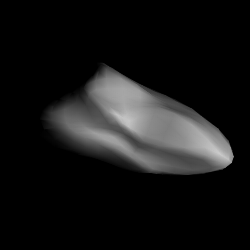
Summary
3103 Eger is an Apollo and Mars-crosser asteroid that was discovered in 1982, by Miklós Lovas. It was named after the city of Eger, Hungary. It has an albedo of 0.64,[1] making it a highly reflective asteroid.
 Shape model of Eger from its lightcurve | |
| Discovery | |
|---|---|
| Discovered by | M. Lovas |
| Discovery site | Piszkéstető |
| Discovery date | 20 January 1982 |
| Designations | |
| (3103) Eger | |
Named after | Eger |
| 1982 BB | |
| Orbital characteristics[1] | |
| Epoch 13 January 2016 (JD 2457400.5) | |
| Uncertainty parameter 0 | |
| Observation arc | 12495 days (34.21 yr) |
| Aphelion | 1.9021 AU (284.55 Gm) |
| Perihelion | 0.90673 AU (135.645 Gm) |
| 1.4044 AU (210.10 Gm) | |
| Eccentricity | 0.35437 |
| 1.66 yr (607.90 d) | |
| 208.62° | |
| 0° 35m 31.92s / day | |
| Inclination | 20.931° |
| 129.792° | |
| 254.007° | |
| Earth MOID | 0.0778981 AU (11.65339 Gm) |
| Proper orbital elements[1][2] | |
Proper eccentricity | 0.325 |
Proper inclination | 22.364° |
Proper mean motion | 99.460 deg / yr |
Proper orbital period | 3.61955 yr (1322.039 d) |
| Physical characteristics | |
Mean diameter | 1.5 km[1] |
| 5.710156±0.000007 h[3] | |
| 0.64[1] | |
| E | |
| 15.38[1] | |
Description edit
It has made and will continue to make many close approaches to Earth. Its closest approach occurred on 6 August 1996, when the asteroid passed 0.11509 AU (17.217 Gm) from Earth.[1] The observed YORP value is (1.4±0.6)×10−8 rad d−2.[3]
3103 Eger is the only asteroid besides 4 Vesta identified as the parent body for specific meteorites. 4 Vesta is the parent body for Howardite, Eucrite, and Diogenite meteorites, while 3103 Eger is the parent body for Aubrite meteorites. In this characteristic 3103 Eger is related spectroscopically to the 434 Hungaria type asteroids, which are a Hirayama-family of orbital types, and E-type asteroids which form a spectroscopical type.
See also edit
References edit
- ^ a b c d e f g "3103 Eger". JPL Small-Body Database. Jet Propulsion Laboratory. SPK-ID: 3103. Retrieved 14 April 2016.
- ^ "(162058) 1997AE12". NEODyS. University of Pisa. Retrieved 25 November 2015.
- ^ a b Durech, J.; Vokrouhlický, D.; Baransky, A. R.; Breiter, S.; Burkhonov, O. A.; Cooney, W.; et al. (November 2012). "Analysis of the rotation period of asteroids (1865) Cerberus, (2100) Ra-Shalom, and (3103) Eger - search for the YORP effect". Astronomy and Astrophysics. 547: 9. arXiv:1210.2219. Bibcode:2012A&A...547A..10D. doi:10.1051/0004-6361/201219396.
External links edit
- Mineralogy of Asteroids
- Relation between E-asteroids, 3103 Eger and 434 Hungaria
- Relations between E-type asteroids 2867 Šteins, a target of the Rosetta mission, and 3103 Eger
- 3103 Eger in the Ondrejov NEO program
- Benner, et al. - Radar Detection of Near-Earth Asteroids 2062 Aten, 2101 Adonis, 3103 Eger, 4544 Xanthus, and 1992 QN (1997)
- 3103 Eger at NeoDyS-2, Near Earth Objects—Dynamic Site
- Ephemerides · Observation prediction · Orbital info · MOID · Proper elements · Observational info · Close approaches · Physical info · Orbit animation
- 3103 Eger at ESA–space situational awareness
- Ephemerides · Observations · Orbit · Physical properties · Summary
- 3103 Eger at the JPL Small-Body Database


